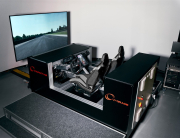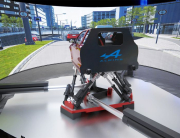
Case Study: TLG Aerospace, LLC
MSC Apex Helps Reduce Time Required to Clean Up and Mesh Geometry by 75%
Overview Wings USA, Inc., a flight services company based in Janesville, Wisconsin, contracted with TLG Aerospace, LLC to analyze a proposed modification to light aircraft. The twin-engine aircraft is to be modified to include a large circular cutout in the floor adjacent to the aircraft door. TLG was asked to analyze the aircraft before and after the modification to determine whether or not the modification would have a significant impact on the fuselage stiffness. TLG engineers generated the pre- and post-modification geometry in CATIA V5. To accommodate the cutout, a section of the longitudinal beam at the center of the floor of the fuselage was removed in addition to a section of skin at the lower outer mold line.

“MSC Apex takes what used to be time consuming and frustrating geometry tasks using traditional programs and turns them instead into efficient and satisfying tasks.”
Robert Lind, Director of Engineering, TLG Aerospace
Challenge The original CAD geometry was created to the normal level of precision achieved in the design process. TLG engineers then faced the time-consuming task of cleaning up the geometry to the higher standards required for finite element analysis and meshing. As is typical with design geometry, the CAD model contained broken surfaces, surfaces that were not stitched together and redundant overlapping surfaces. In this case, the OML curvature did not match stiffeners, frames, intercostals and beams in 58 locations. TGL estimated that 348 minutes would have been required to manually make these corrections using traditional surface geometry tools. The geometry also contained non-congruent surfaces including gaps, interferences and non-mating surface geometry in 44 locations. An estimated 4 minutes would have been required to clean up each location for a total of 176 minutes.
The CAD model also contained many extra details not needed for finite element analysis. A complex surface created in a CAD system is unlikely to have perfect curvature and tangency so the CAD system automatically generates facets. The finite element preprocessor adds a line of nodes along these facets that skews the mesh, causing poor element quality that reduces analysis accuracy. Extraneous facets were found in four surface locations that would have required an estimated 15 minutes per location cleanup time for a total of 1 hour.
Total cleanup time for the pre-mod configuration was 9.7 hours. The post-mod configuration required a similar cleanup effort, however, a majority of this work from the pre-mod configuration could have been applied to the post-mod configuration.
TLG engineers made the assumption that 30% of the total time required for cleaning up the pre-mod configuration using traditional surface geometry tools or 2.9 hours would have been required for the post-mod configuration. So the total cleanup time would have amounted to 12.6 hours. TLG engineers also assumed that the meshing time for both the pre-mod and post-mod configuration would have been equal to the cleanup time, so total geometry cleanup and meshing time would have amounted to 25.2 hours.
Solution/Validation TLG Aerospace engineers addressed these challenges by performing the cleanup and meshing with the MSC Apex computational parts based computer aided engineering (CAE) system which features a complete set of direct modeling tools to improve geometry cleanup and meshing productivity. “MSC Apex takes what used to be time consuming and frustrating geometry tasks using traditional programs and turns them instead into efficient and satisfying tasks,” said Robert Lind, Director of Engineering at TLG Aerospace.



This allows the user to achieve a high quality mesh in significantly less time when compared to traditional meshing applications.
TLG engineers simply drew a selection box around the entire model and entered a command to stich up the surfaces. This one command fixed approximately 70% of the surfaces in the model. They closed up remaining gaps and eliminated overlaps by dragging surfaces to close and form congruent surfaces. TLG engineers matched up stiffeners, frames, intercostals and beams to the OML simply by dragging the components into the OML at which point Apex automatically mated up the parts for a congruent surface. Engineers selected facets both by clicking on them and by enclosing a number of them in a selection box. Then they removed all of the selected facets with a single command. As the geometry was cleaned up, the mesh automatically updated, so no additional time was required for meshing. This also made it possible to use the meshing results to determine the best approach to cleaning up the geometry. The total time required using Apex to clean up the geometry and create the mesh was approximately 3 hours per configuration for a total of 6 hours, a savings of 76% compared to traditional tools.
Results
TLG engineers created a RBE2 rigid body element at the forward end of the OML to restrain the fuselage at a station forward of the door. The RBE2 independent node was located at the centroid of the section and was restrained in all 6 degrees of freedom. An RBE3 interpolation element was created at the aft end of the OML with the RBE2 independent node projected onto the aft end plane. A unit load was applied to the RBE3 central node in the vertical. A unit load was applied to the RBE3 dependent node in the vertical, lateral, and torsional directions. The relative stiffness delta between the pre-mod and post-mod analysis was then compared. The results provided the data needed to move forward with the modification analysis.
About TLG Aerospace
TLG Aerospace, LLC is an aerospace engineering services company that provides design, analysis and certification for new and modified aircraft and related aerospace products. TLG specializes in full vehicle analysis and optimization including static and dynamic loads, flutter, stability and control, aerodynamic design, Computational Fluid Dynamics (CFD) analysis, FAA certification and aircraft performance and handling qualities. The company’s engineers have experience with over 100 aircraft models from more than 40 different manufacturers.






Leave A Comment